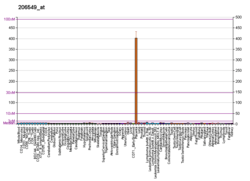INSL4
Early placenta insulin-like peptide is a protein that in humans is encoded by the INSL4 gene.[3][4][5]
| INSL4 | |||||||||||||||||||||||||
|---|---|---|---|---|---|---|---|---|---|---|---|---|---|---|---|---|---|---|---|---|---|---|---|---|---|
| Identifiers | |||||||||||||||||||||||||
| Aliases | INSL4, EPIL, PLACENTIN, insulin like 4 | ||||||||||||||||||||||||
| External IDs | OMIM: 600910 HomoloGene: 88662 GeneCards: INSL4 | ||||||||||||||||||||||||
| |||||||||||||||||||||||||
| |||||||||||||||||||||||||
| |||||||||||||||||||||||||
| Orthologs | |||||||||||||||||||||||||
| Species | Human | Mouse | |||||||||||||||||||||||
| Entrez |
| ||||||||||||||||||||||||
| Ensembl |
| ||||||||||||||||||||||||
| UniProt |
| ||||||||||||||||||||||||
| RefSeq (mRNA) |
| ||||||||||||||||||||||||
| RefSeq (protein) |
| ||||||||||||||||||||||||
| Location (UCSC) | Chr 9: 5.23 – 5.24 Mb | n/a | |||||||||||||||||||||||
| PubMed search | [2] | n/a | |||||||||||||||||||||||
| Wikidata | |||||||||||||||||||||||||
| |||||||||||||||||||||||||
INSL4 encodes the insulin-like 4 protein, a member of the insulin superfamily. INSL4 encodes a precursor that undergoes post-translational cleavage to produce 3 polypeptide chains, A-C, that form tertiary structures composed of either all three chains, or just the A and B chains. Expression of INSL4 products occurs within the early placental cytotrophoblast and syncytiotrophoblast.[5]
References
- GRCh38: Ensembl release 89: ENSG00000120211 - Ensembl, May 2017
- "Human PubMed Reference:". National Center for Biotechnology Information, U.S. National Library of Medicine.
- Chassin D, Laurent A, Janneau JL, Berger R, Bellet D (Aug 1996). "Cloning of a new member of the insulin gene superfamily (INSL4) expressed in human placenta". Genomics. 29 (2): 465–70. doi:10.1006/geno.1995.9980. PMID 8666396.
- Veitia R, Laurent A, Quintana-Murci L, Ottolenghi C, Fellous M, Vidaud M, McElreavey K (Oct 1998). "The INSL4 gene maps close to WI-5527 at 9p24.1→p23.3 clustered with two relaxin genes and outside the critical region for the monosomy 9p syndrome". Cytogenet Cell Genet. 81 (3–4): 275–7. doi:10.1159/000015045. PMID 9730618.
- "Entrez Gene: INSL4 insulin-like 4 (placenta)".
Further reading
- Koman A, Cazaubon S, Couraud PO, et al. (1996). "Molecular characterization and in vitro biological activity of placentin, a new member of the insulin gene family". J. Biol. Chem. 271 (34): 20238–41. doi:10.1074/jbc.271.34.20238. PMID 8702754.
- Bellet D, Lavaissiere L, Mock P, et al. (1997). "Identification of pro-EPIL and EPIL peptides translated from insulin-like 4 (INSL4) mRNA in human placenta". J. Clin. Endocrinol. Metab. 82 (9): 3169–72. doi:10.1210/jc.82.9.3169. PMID 9284764.
- Laurent A, Rouillac C, Delezoide AL, et al. (1999). "Insulin-like 4 (INSL4) gene expression in human embryonic and trophoblastic tissues". Mol. Reprod. Dev. 51 (2): 123–9. doi:10.1002/(SICI)1098-2795(199810)51:2<123::AID-MRD1>3.0.CO;2-S. PMID 9740319.
- Janneau JL, Maldonado-Estrada J, Tachdjian G, et al. (2002). "Transcriptional expression of genes involved in cell invasion and migration by normal and tumoral trophoblast cells". J. Clin. Endocrinol. Metab. 87 (11): 5336–9. doi:10.1210/jc.2002-021093. PMID 12414911.
- Strausberg RL, Feingold EA, Grouse LH, et al. (2003). "Generation and initial analysis of more than 15,000 full-length human and mouse cDNA sequences". Proc. Natl. Acad. Sci. U.S.A. 99 (26): 16899–903. doi:10.1073/pnas.242603899. PMC 139241. PMID 12477932.
- Bièche I, Laurent A, Laurendeau I, et al. (2004). "Placenta-specific INSL4 expression is mediated by a human endogenous retrovirus element". Biol. Reprod. 68 (4): 1422–9. doi:10.1095/biolreprod.102.010322. PMID 12606452.
- Humphray SJ, Oliver K, Hunt AR, et al. (2004). "DNA sequence and analysis of human chromosome 9". Nature. 429 (6990): 369–74. doi:10.1038/nature02465. PMC 2734081. PMID 15164053.
- Zhang Z, Henzel WJ (2005). "Signal peptide prediction based on analysis of experimentally verified cleavage sites". Protein Sci. 13 (10): 2819–24. doi:10.1110/ps.04682504. PMC 2286551. PMID 15340161.
- Gerhard DS, Wagner L, Feingold EA, et al. (2004). "The status, quality, and expansion of the NIH full-length cDNA project: the Mammalian Gene Collection (MGC)". Genome Res. 14 (10B): 2121–7. doi:10.1101/gr.2596504. PMC 528928. PMID 15489334.
- Millar L, Streiner N, Webster L, et al. (2006). "Early placental insulin-like protein (INSL4 or EPIL) in placental and fetal membrane growth". Biol. Reprod. 73 (4): 695–702. doi:10.1095/biolreprod.105.039859. PMC 1382170. PMID 15958731.
This article is issued from Wikipedia. The text is licensed under Creative Commons - Attribution - Sharealike. Additional terms may apply for the media files.


